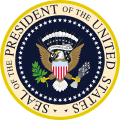Despite the following occurrences, Lincoln's health up until middle age was fairly good for his day. [1] [2]
Mental health
Lincoln was contemporaneously described as suffering from melancholy, a condition that modern mental health professionals would characterize as clinical depression. [17] Lincoln suffered from a depressed mood after major traumatic events, such as the death of Ann Rutledge in August 1835, [18] the cessation of his (purported) engagement to Mary Todd Lincoln in January 1841 (after which several close associates feared Lincoln's suicide), [19] [a] and the Second Battle of Bull Run. [21] During his life Lincoln experienced the death of multiple close family members, including his mother, his sister, and two of his sons, Eddie and Willie. [22] Mary Lincoln felt her husband to be too trusting, and his melancholy tended to strike when he was betrayed or unsupported by those in whom he put faith. [23] Whether he may have suffered from depression as a genetic predilection, a reaction to multiple emotional traumas in his life, [22] or a combination thereof is the subject of much current conjecture. [24]
Lincoln often combated his melancholic moods by delving into works of humor, likely a healthy coping mechanism for his depression. [25]
Medication
The recollections of Lincoln's legal colleagues (John T. Stuart, Henry Clay Whitney, Ward Hill Lamon, and William Herndon) all agree that Lincoln took blue mass pills, [26] which were commonly prescribed for hypochondriasis [b] and melancholia. [27] It has been used since the 16th century to treat syphilis and by the mid-19th century was prescribed for a wide variety of ills. [27] The active ingredient of blue mass is elemental mercury – a substance now known to be a neurotoxin in its valproic state [28] [c] and which has been known to be poisonous for centuries. [27] [d]
Lincoln may have taken the blue mass pills for constipation, [27] [26] as well as hypochondriasis, or what has been called persistent constipation-melancholia complex. Both conditions were well known by his friends and family to have significantly affected Lincoln throughout his life. [27] [e]
Authors of Abraham Lincoln's Blue Pills: Did Our 16th President Suffer from Mercury Poisoning? find that it is a reasonable assumption that Lincoln had experienced mercury poisoning due to the differences in his behavior and physical condition when he was taking the blue mass pills versus when he stopped taking the pills. [27] When he was taking the blue mass pills, he was prone to outbursts of rage, bizarre behavior, memory loss, and insomnia. His hands trembled when he was under stress. Taking the medicine made Lincoln feel "cross". These issues, described in detail by those who were close to him, are common symptoms of mercury poisoning. When he stopped taking the medicine, and during a period of profound personal and professional stress, he "behaves like a saint". [27] [f] Lincoln may also have had long-term effects as the result of mercury poisoning, such as nerve damage that affected his gait. [27]
Shortly after his 1861 inauguration, Lincoln had a sudden and disquieting outburst of rage during a White House conversation. Finding that the blue mass pills made him "cross", Lincoln stopped taking them about August 1861 (5 months after his March inauguration). Then his anger greatly diminished, so much so that he rarely expressed anger and then only when it was situationally appropriate. [27]
The remarkable thing about Lincoln's temper is not how often it erupted, but how seldom it did, considering how frequently he encountered the insolence of epaulets, the abuse of friends and opponents alike, and the egomaniacal selfishness of editors, senators, representatives, governors, cabinet members, generals, and flocks of others who pestered him unmercifully about their own petty concerns.
— Thomas L. Carson, Lincoln's Ethics, Cambridge University Press, 2015, p. 246. [27]
Body habitus
The habitus, or structure, of Lincoln's body attracted attention while he was alive, and continues to attract attention today among medical professionals. [31]
- Height: as a child, Lincoln was tall, describing himself as "though very young, he was large of his age." [32] He reached his adult height of 6 feet 4 inches (1.93 m) no later than age 21.
- Weight: although well-muscled as a young adult, he was always thin. Questionable evidence says Lincoln weighed over 200 pounds (91 kg) in 1831, [33] but this is inconsistent with the emphatic statement of Henry Lee Ross ("The facts are Lincoln never weighed over 175 pounds in his life"), [34] the recollection of David Turnham ("weighed about 160 lbs in 1830"), [35] and a New Salem neighbor named Camron ("thin as a beanpole and ugly as a scarecrow"). Lincoln's self-reported weight was 180 pounds (82 kg) in 1859. [36] He is believed to have weighed even less during his presidency. [37]
The theory that Lincoln's facial asymmetries were a manifestation of craniofacial microsomia [38] has been replaced with a possible diagnosis of left synostotic frontal plagiocephaly, [31] which is a type of craniosynostosis.


